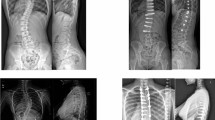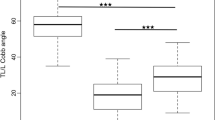Abstract
Purpose
The treatment of operative double major pediatric spinal deformities (e.g., Lenke 3 or 6) with bilateral vertebral body tethering (VBT) can be significantly more challenging when compared to other deformity patterns (e.g., Lenke 1) or treatment with a posterior spinal fusion. We aimed to identify preoperative and perioperative characteristics that were associated with successful postoperative outcomes in patients treated with both a thoracic and thoracolumbar (e.g., bilateral) tether.
Methods
We retrospectively assessed radiographic and clinical data from patients enrolled in a large multi-center study who had a minimum postoperative follow-up of two years. Standard radiographic parameters were extracted from standing spine and left hand-wrist radiographs at various timepoints. We classified patients based on their preoperative deformity pattern (Primary Thoracic [TP] vs. Primary Thoracolumbar [TLP]) and assessed: (1) deformity balance, (2) tilt of the transitional vertebra, and (3) postoperative success.
Results
We analyzed data from thirty-six patients (TP: 19 and TLP: 17). We observed no relationship between deformity balance at first erect and postoperative success (p = 0.354). Patients with a horizontal transitional vertebra at first erect were significantly (p = 0.001) more likely to exhibit a successful outcome when compared to those who exhibited a tilted transitional vertebra (83% vs. 62%). Patients who had TLP were also more likely to exhibit a successful outcome when compared to patients who exhibited TP (76% vs. 50%).
Conclusion
These data indicate that double major deformities can be successfully treated with VBT, particularly for those who exhibit TLP.




Similar content being viewed by others
Availability of data and material
The original data used in this manuscript are available from the Harms Study Group and the Setting Scoliosis Straight Registries. These data are restricted and not publicly available; however, inquires can be made to Michelle Marks at mmarks@sshsg.org.
Code availability
Not applicable.
References
Konieczny MR, Senyurt H, Krauspe R (2013) Epidemiology of adolescent idiopathic scoliosis. J Child Orthop 7:3–9. https://doi.org/10.1007/s11832-012-0457-4
Green D, Lawhorne T, Widmann R et al (2011) Long-term magnetic resonance imaging follow-up demonstrates minimal transitional level lumbar disc degeneration after posterior spine fusion for adolescent idiopathic scoliosis. Spine 36:1948–1954. https://doi.org/10.1097/BRS.0b013e3181ff1ea9
Kepler C, Meredith D, Green D, Widmann R (2012) Long-term outcomes after posterior spine fusion for adolescent idiopathic scoliosis. Curr Opin Pediatr 24:68–75. https://doi.org/10.1097/MOP.0b013e32834ec982
Lonner BS, Ren Y, Upasani VV et al (2018) Disc degeneration in unfused caudal motion segments ten years following surgery for adolescent idiopathic scoliosis. Spine Deform 6:684–690. https://doi.org/10.1016/j.jspd.2018.03.013
Hoernschemeyer D, Boeyer M, Robertson M et al (2020) Anterior vertebral body tethering for adolescent scoliosis with growth remaining: a retrospective review of 2 to 5-year postoperative results. J Bone Joint Surg Am 102:1169–1176
Newton P, Kluck D, Saito W et al (2018) Anterior spinal growth tethering for skeletally immature patients with scoliosis: a retrospective look two to four years postoperatively. J Bone Joint Surg Am 100:1691–1697
Samdani A, Ames R, Kimball J et al (2014) Anterior vertebral body tethering for idiopathic scoliosis: two-year results. Spine 39:1688–1693
McDonald TC, Shah SA, Hargiss JB et al (2022) When successful, anterior vertebral body tethering (VBT) induces differential segmental growth of vertebrae: an in vivo study of 51 patients and 764 vertebrae. Spine Deform 10:791–797. https://doi.org/10.1007/s43390-022-00471-2
Yucekul A, Akpunarli B, Durbas A et al (2021) Does vertebral body tethering cause disc and facet joint degeneration? A preliminary MRI study with minimum 2-years follow-up. Spine J. https://doi.org/10.1016/j.spinee.2021.05.020
Boeyer ME, Farid S, Wiesemann S, Hoernschemeyer DG (2023) Outcomes of vertebral body tethering in the lumbar spine. Spine Deform. https://doi.org/10.1007/s43390-023-00662-5
Pehlivanoglu T, Oltulu I, Erdag Y et al (2021) Comparison of clinical and functional outcomes of vertebral body tethering to posterior spinal fusion in patients with adolescent idiopathic scoliosis and evaluation of quality of life: preliminary results. Spine Deform. https://doi.org/10.1007/s43390-021-00323-5
Nicolini LF, Kobbe P, Seggewiß J et al (2022) Motion preservation surgery for scoliosis with a vertebral body tethering system: a biomechanical study. Eur Spine J 31:1013–1021. https://doi.org/10.1007/s00586-021-07035-4
Pehlivanoglu T, Oltulu I, Erdag Y et al (2021) Double-sided vertebral body tethering of double adolescent idiopathic scoliosis curves: radiographic outcomes of the first 13 patients with 2 years of follow-up. Eur Spine J. https://doi.org/10.1007/s00586-021-06745-z
Zimmer Biomet (2019) Zimmer Biomet’s Innovative Treatment for Young Patients with Scoliosis Receives FDA Approval. https://investor.zimmerbiomet.com/news-and-events/news/2019/08-16-2019-160833526
Sanders J, Khoury J, Kishan S et al (2008) Predicting scoliosis progression from skeletal maturity: a simplified classification during adolescence. J Bone Joint Surg Am 90:540–553. https://doi.org/10.2106/JBJS.G.00004
Lenke LG, Betz RR, Harms J et al (2001) Adolescent idiopathic scoliosis: a new classification to determine extent of spinal arthrodesis. JBJS 83:1169
Weinstein SL, Dolan LA, Cheng JC et al (2008) Adolescent idiopathic scoliosis. The Lancet 371:1527–1537. https://doi.org/10.1016/S0140-6736(08)60658-3
Rathbun JR, Hoernschemeyer DS, Wakefield MR et al (2019) Ureteral injury following vertebral body tethering for adolescent idiopathic scoliosis. J Pediatr Surg Case Rep 46:101219. https://doi.org/10.1016/j.epsc.2019.101219
Buyuk AF, Milbrandt TA, Mathew SE et al (2021) Does preoperative and intraoperative imaging for anterior vertebral body tethering predict postoperative correction? Spine Deform 9:743–750. https://doi.org/10.1007/s43390-020-00267-2
Yilgor C, Miyanji F, Parent S, et al (2021) Is VBT safe and effective for ≥60º main thoracic curves? A matched cohort analysis. https://reader.elsevier.com/reader/sd/pii/S277252942100045X?token=4802D62419B597DC76F98EC557A79FAD8031E511A8D4922FF71BA22F2AF818F161982CF75429CF67D443B3CD2756DBF9&originRegion=us-east-1&originCreation=20230301230217. Accessed 1 Mar 2023
Trobisch PD, Baroncini A (2021) Preliminary outcomes after vertebral body tethering (VBT) for lumbar curves and subanalysis of a 1- versus 2-tether construct. Eur Spine J. https://doi.org/10.1007/s00586-021-07009-6
Kim D-H, Hyun S-J, Kim K-J (2021) Selection of fusion level for adolescent idiopathic scoliosis surgery: selective fusion versus postoperative decompensation. J Korean Neurosurg Soc 64:473–485. https://doi.org/10.3340/jkns.2020.0258
Miyanji F, Pawelek J, Nasto LA et al (2020) Safety and efficacy of anterior vertebral body tethering in the treatment of idiopathic scoliosis. Bone Joint J 102-B:1703–1708. https://doi.org/10.1302/0301-620X.102B12.BJJ-2020-0426.R1
Newton P, Bartley C, Bastrom T et al (2020) Anterior spinal growth modulation in skeletally immature patients with idiopathic scoliosis: a comparison with posterior spinal fusion at 2 to 5 years postoperatively. J Bone Joint Surg Am 102:769–777
Acknowledgements
Harms Study Group Consortium Members: Aaron Buckland, MD; New York University. Ahmet Alanay, MD; Acibadem Maslak Hospital, Turkey. Amer Samdani, MD; Shriners Hospitals for Children—Philadelphia. Amit Jain, MD; Johns Hopkins Hospital. A. Noelle Larson, MD; Mayo Clinic Rochester Minnesota. Baron Lonner, MD; Mount Sinai Hospital. Benjamin Roye, MD; Columbia University. Bob Cho, MD; Shriner’s Pasadena CA. Burt Yaszay, MD; Seattle Children's Hospital. Caglar Yilgor, MD; Acibadem Maslak Hospital, Turkey. Chris Reilly, MD; BC Children’s Hospital. Dan Hoernschmeyer, MD; University of Missouri Health Care. Daniel Hedequist, MD; Boston Children’s Hospital. Daniel Sucato, MD; Texas Scottish Rite Hospital. David Clements, MD; Cooper Bone & Joint Institute New Jersey. Firoz Miyanji, MD; BC Children’s Hospital. Harry Shufflebarger, MD; Paley Orthopedic & Spine Institute. Jack Flynn, MD; Children’s Hospital of Philadelphia. Jean Marc Mac Thiong, MD; CHU Sainte-Justine. John Asghar, MD; Paley Orthopedic & Spine Institute. Josh Murphy, MD; Children's Healthcare of Atlanta. Joshua Pahys, MD; Shriners Hospitals for Children—Philadelphia. Juergen Harms, MD; Klinikum Karlsbad-Langensteinbach, Karlsbad. Keith Bachmann, MD; University of Virginia. Kevin Neal, MD; Nemours Children’s Clinic, Jacksonville. Laurel Blakemore, MD; Pediatric Specialists of Virginia/Children’s National. Lawrence Haber, MD; Ochsner Health Center for Children, New Orleans. Lawrence Lenke, MD; Columbia University. Lori Karol, MD; Children’s Hospital, Denver Colorado. Mark Abel, MD; University of Virginia. Mark Erickson, MD; Children’s Hospital, Denver Colorado. Michael Glotzbecker, MD; Rainbow Children’s Hospital, Cleveland. Michael Kelly, MD; Washington University. Michael Vitale, MD; Columbia University. Michelle Marks, PT, MA; Setting Scoliosis Straight Foundation. Munish Gupta, MD; Washington University. Nicholas Fletcher, MD; Emory University. Patrick Cahill, MD; Children’s Hospital of Philadelphia. Paul Sponseller, MD; Johns Hopkins Hospital. Peter Gabos, MD: Nemours/Alfred I. duPont Hospital for Children. Peter Newton, MD; Rady Children’s Hospital. Peter Sturm, MD; Cincinnati Children’s Hospital. Randal Betz, MD; Institute for Spine & Scoliosis. Stefan Parent, MD: CHU Sainte-Justine. Stephen George, MD; Nicklaus Children's Hospital. Steven Hwang, MD; Shriners Hospitals for Children—Philadelphia. Suken Shah, MD; Nemours/Alfred I. duPont Hospital for Children. Sumeet Garg, MD; Children’s Hospital, Denver Colorado. Tom Errico, MD; Nicklaus Children's Hospital. Vidyadhar Upasani, MD; Rady Children’s Hospital.
Funding
No direct funding was provided for the work presented herein. We did, however, retrospectively assess data from the Harms Study Group, which received external funding from several sources.
Author information
Authors and Affiliations
Consortia
Contributions
Daniel G. Hoernschemeyer contributed to the conception, design, data acquisition, data interpretation, revised manuscript, approved final version, and agreed to be accountable; Patrick Elliott assisted in the conception, design, data acquisition, data interpretation, drafted manuscript, approved final version, and agreed to be accountable; Baron S. Lonner was involved in the conception, data acquisition, data interpretation, revised manuscript, approved final version, and agreed to be accountable; Lily Eaker contributed to the conception, data interpretation, revised manuscript, approved final version, and agreed to be accountable; Harms Study Group assisted in the data acquisition, data interpretation, revised manuscript, approved final version, and agreed to be accountable; Melanie E. Boeyer was involved in the conception, design, data analysis, data interpretation, drafted manuscript, revised manuscript, approved final version, and agreed to be accountable.
Corresponding author
Ethics declarations
Conflict of interest
There are several authors of this work that have financial disclosures; however, none are directly related to the work presented herein.
Consent for participation and publication
This was a retrospective study that did not require assent and/or consent specific to this study for any of the participants. This procedure was approved by the Institutional Review Board for each participating Medical Center.
Ethical approval
The procedures outlined herein were approved by the Institutional Review Board for each participating Medical Center.
Additional information
Publisher's Note
Springer Nature remains neutral with regard to jurisdictional claims in published maps and institutional affiliations.
Rights and permissions
Springer Nature or its licensor (e.g. a society or other partner) holds exclusive rights to this article under a publishing agreement with the author(s) or other rightsholder(s); author self-archiving of the accepted manuscript version of this article is solely governed by the terms of such publishing agreement and applicable law.
About this article
Cite this article
Hoernschemeyer, D.G., Elliott, P., Lonner, B.S. et al. Bilateral vertebral body tethering: identifying key factors associated with successful outcomes. Eur Spine J 33, 723–731 (2024). https://doi.org/10.1007/s00586-023-08074-9
Received:
Revised:
Accepted:
Published:
Issue Date:
DOI: https://doi.org/10.1007/s00586-023-08074-9




